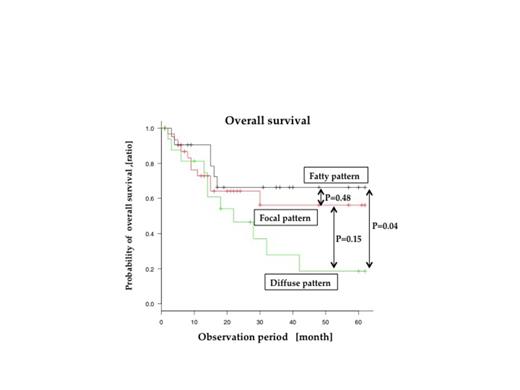Abstract

Background: Myelodysplastic syndrome (MDS) and aplastic anemia (AA) comprise a heterogeneous group of bone marrow failure disorders. As both show profound hypocellular marrow with minimal morphological atypia, differentiation of MDS and AA is often difficult by bone marrow and laboratory examination alone. Red to yellow marrow conversion occurs with age in the appendicular skeleton (AS), where red marrow is converted to yellow marrow until the early 20s. Although an abnormal distribution of red marrow in AS has previously been reported in small numbers of patients with MDS, along with leukemia and lymphoma by MRI, there have been no further reports to date. Here, we examined the distribution of red marrow in AS by low-dose multi-detector CT (MDCT) in AA and MDS. We analyzed the relationships between the abnormal medullary pattern in AS and laboratory variables, subsequent development of leukemic transformation, and survival in MDS patients.
Patients: We performed low-dose MDCT of the humerus and femur in 103 untreated adult patients with AA (n = 32) and MDS (n = 71). We retrospectively reviewed the medical records of patients with AA and MDS diagnosed in the Department of Hematology/Oncology at Kameda Medical Center, Kamogawa, Japan, from July 2008 to June 2014. A retrospective review of clinical and laboratory features, including complete blood count, % bone marrow blasts, chromosomal analysis, and International Prognostic Scoring System (IPSS), was performed. WHO classification of MDS patients was as follows: RA (n = 22), RARS (n = 2), RCMD (n = 17), RAEB 1 (n = 18), RAEB 2 (n = 11), and MDS unclassified (n = 1). Overall survival (OS) and leukemia-free survival (LFS) were analyzed in 71 MDS patients by the Kaplan–Meier method and differences between curves were calculated by two-sided log-rank test.
CT image acquisition and image analysis: Non-enhanced CT examinations were performed from the base of the skull down to the knee joint with an MS-CT scanner (AQUILION 64; Toshiba, Tokyo, Japan). The bony canals of the humeral and femoral bones were visualized by coronal and sagittal axis image reconstruction. The effective radiation dose associated with whole-body MD-CT was 10.1 mSv (ICRP 26). The dose was comparable to whole-body CT (2.4 mSv). Medullary CT density of the humerus and femur were measured and the results are expressed in Hounsfield units (HU). As the normal adult bone marrow was composed of rich adipocytes and called yellow marrow, it is represented by a low-density CT value between –30 and –100 HU. A value above –30 HU observed in long bony canals was considered to indicate a high-density lesion. The medullary pattern of the appendicular skeleton was categorized as follows: (1) fatty, showing a low signal density marrow; (2) focal, showing abnormally focal high-density lesions; (3) diffuse, showing uniformly high-density marrow.
Results: All 15 patients with AA showed a fatty (n = 12, 37.5%) or focal (n = 20, 62.5%) pattern in medullary AS on MDCT, and none showed a diffuse pattern. Among the 71 patients with MDS, 22 (30.9%) had a fatty pattern, 32 (45.1%) had a focal pattern, and 17 (23.9%) had a diffuse pattern. Seventeen patients with diffuse infiltration pattern on MDCT had significantly shorter LFS (P < 0.01, P = 0.02) compared to 23 patients with fatty pattern and 32 patients with focal medullary pattern (median LFS: 18 months vs. not reached vs. not reached, respectively). Seventeen patients with a diffuse infiltration pattern on MDCT had significantly shorter OS (P = 0.04) compared to 23 patients with a fatty pattern, but the difference was no significant compared to 32 with a focal medullary pattern (P = 0.15) (median OS: 22 months vs. not reached vs. not reached, respectively). The characteristics of the patients with diffuse pattern did not differ significantly in terms of sex, age, WBC count, platelet count, karyotype, WT1, or IPSS classification from those of patients with a fatty or focal pattern, but patients with a diffuse infiltration pattern on MDCT had a significantly low hemoglobin concentration compared to those with a fatty or focal medullary pattern (P = 0.03).
Conclusions: This study showed that MDCT imaging of the appendicular skeleton provided important information for the diagnosis and prognosis of patients with MDS and AA. In patients with MDS, a diffuse pattern on MDCT emerged as an independent negative prognostic indicator on LFS and OS.
No relevant conflicts of interest to declare.
Author notes
Asterisk with author names denotes non-ASH members.

This icon denotes a clinically relevant abstract



This feature is available to Subscribers Only
Sign In or Create an Account Close Modal